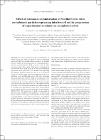| dc.contributor.author | ATKINS, GREGORY JULIAN | |
| dc.date.accessioned | 2010-08-18T10:27:27Z | |
| dc.date.available | 2010-08-18T10:27:27Z | |
| dc.date.issued | 2008 | |
| dc.date.submitted | 2008 | en |
| dc.identifier.citation | Quinn,K, Galbraith, SE, Sheahan, BJ, Atkins, GJ., Effect of intranasal administration of Semliki Forest virus recombinant particles expressing interferon-? on the progression of experimental autoimmune encephalomyelitis., Molecular Medicine Reports., 1, 3, 2008, 335 - 342 | en |
| dc.identifier.other | Y | |
| dc.identifier.uri | http://hdl.handle.net/2262/40497 | |
| dc.description | PUBLISHED | en |
| dc.description.abstract | The effect of intranasal (IN) administration of Semliki Forest virus (SFV) recombinant particles expressing interferon-? [IFN-?, a partially effective treatment for multiple sclerosis (MS)] on the progression of experimental autoimmune encephalomyelitis (EAE, a murine model for MS) was investigated. The murine IFN-? gene was cloned from SFV-infected mouse brain by RT-PCR into an SFV-enhanced expression vector, pSFV10-E, from which IFN-?-expressing recombinant particles (rSFV10-E-IFN-?) were prepared. Expression studies using immunohistochemistry and viral inhibition assay in BHK and murine L929 cells confirmed increased expression of IFN-?. High level expression in the central nervous system (CNS) following IN inoculation was confirmed by the excision of olfactory bulbs, brain and spinal cord, and the detection of IFN-? levels in homogenised tissue by ELISA. rSFV10-E-IFN-? particles were administered IN to C57/Bl6 mice that had been induced for EAE using the encephalogenic peptide myelin oligodendrocyte glycoprotein (MOG) 35-55. The progression of EAE was measured by clinical score, weight loss and pathology. As previously shown, treatment with empty rSFV10-E particles moderately exacerbated EAE, as did continuous treatment with rSFV10-E-IFN-? particles. Inhibition of disease with rSFV10-E-IFN-? particles was dependent on the number and timing of treatments. Fewer treatments, administered before the effector stage, led to an improvement in clinical and pathology score. In conclusion, the timing and frequency of IN administration of rSFV10-E-IFN-? particles are critical to disease outcome, with treatment prior to the effector stage being most effective. | en |
| dc.description.sponsorship | We thank Dorothy Mooney for assistance with the laboratory
protocols and Alex Whelan-Buckley for assistance with the
histopathological studies. We also thank Margaret Morris-
Downes and Alan Jerusalmi for all their assistance and advice
in setting up the EAE model. This work was supported by the
National Neuroscience Network of Ireland, the European
Union 5th Framework Programme, The Multiple Sclerosis
Society of Ireland and Enterprise Ireland | en |
| dc.format.extent | 335 | en |
| dc.format.extent | 342 | en |
| dc.language.iso | en | en |
| dc.publisher | Spandidos | en |
| dc.relation.ispartofseries | Molecular Medicine Reports.; | |
| dc.relation.ispartofseries | 1; | |
| dc.relation.ispartofseries | 3; | |
| dc.rights | Y | en |
| dc.subject | Immunology | en |
| dc.subject | Semliki Forest virus | en |
| dc.title | Effect of intranasal administration of Semliki Forest virus recombinant particles expressing interferon-? on the progression of experimental autoimmune encephalomyelitis. | en |
| dc.type | Journal Article | en |
| dc.contributor.sponsor | Enterprise Ireland | en |
| dc.type.supercollection | scholarly_publications | en |
| dc.type.supercollection | refereed_publications | en |
| dc.identifier.peoplefinderurl | http://people.tcd.ie/gatkins | |
| dc.identifier.rssinternalid | 54978 | |
| dc.identifier.rssuri | http://www.spandidos-publications.com/mmr/1/3/335 | en |




